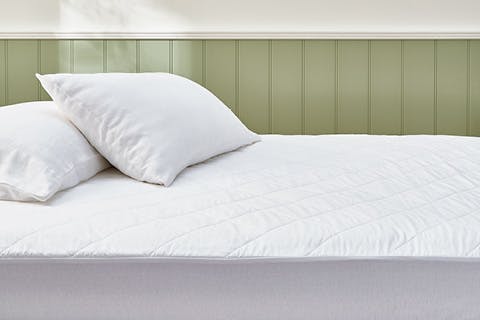How to wash a mattress protector

Mattress protectors certainly win the award for quiet achiever when it comes to your bedding. A humble mattress protector will not only prolong the life of your mattress by protecting it from spills and stains, but it can also help protect your family from dust mites, mould and bacteria allergens.
Mattress protectors come in different materials – cotton, bamboo, Tencel™ and synthetic fibres like polyester. Waterproof mattress protectors usually incorporate a membrane (often made of Polyurethane), which can act as a barrier against moisture.
While you don’t have to wash your mattress protector as often as the rest of your bedding, it’s recommended that you do so once every two months. When it comes time to wash your mattress protector, it can be a little daunting (especially if it contains waterproofing material that requires extra care). However, if you follow the right steps, caring for your mattress protector can be simple and stress-free.

Washing a mattress protector
If you’re wondering, can you wash a mattress protector? The answer is: of course! The good news is cleaning your mattress protector is fairly easy – although it’s important to always check the label, as different mattress protectors will have varying instructions for washing and drying.
Generally, it’s best to wash at 60'C to kill bacteria and dust mites. Opt for a mild laundry detergent (we recommend one that is eco-friendly and biodegradable) and avoid any harsh chemicals or bleach.
Here are some simple steps to follow when washing your mattress protector:
- Remove the mattress protector from your bed and check the label for any specific washing instructions
- Inspect for stains and treat with a stain remover (if your mattress protector is dusty, consider vacuuming it)
- Place your mattress protector inside your washing machine and choose a gentle cycle using water that is 60'C.
- Use a mild laundry detergent and avoid any harsh chemicals or bleach.
How do you clean a mattress protector without a washing machine?
Whether you’re tackling stains and spills (or you don’t want to chuck the entire thing in the wash), you might want to clean a mattress protector without a washing machine.
The sooner you treat stains, the easier they are to remove – so if your morning coffee accidentally goes sideways, it’s best to address it immediately. Use a stain remover (enzyme stain removers are highly effective) or a combination of mild detergent, water and a clean cloth to spot clean stains. You can also soak the mattress protector with cold or lukewarm water and a mild detergent. Check the instructions on the care label for further information.

How to dry a mattress protector
The best way to dry a mattress protector is to hang it on a clothesline and let it air dry in the sun (nature’s very own drier) for at least 24 hours. Of course, this might not always be an option, depending on the weather or if you have a backyard. So, can you put a mattress protector in a dryer? The short answer is yes. Sticking to a low-heat setting may be wise to avoid damaging or shrinking your mattress protector, and always read the care instructions before throwing it into the dryer. However, keep an eye out for blisters from overheating. If you notice this, then stop using the mattress protector as the blisters can split and result in a loss of waterproofing ability.
While an at-home tumble dryer may be okay, never take your mattress protector to a dry cleaner. Mattress protectors are not made to withstand extreme heat, and if they contain Polyurethane, this may blister, reducing the waterproofing capabilities of the mattress protector.
Lastly, ensure your mattress protector is completely dry before putting it back on the mattress, as moisture can cause mildew.

How to make sure your mattress protector will last
Most mattress protectors last around one or two years, and you can help maximise their life with the correct care.
Here are a few tips to remember when it comes to keeping your mattress protector in great condition:
- Avoid the use of harsh chemicals when washing or spot-cleaning your mattress protector
- Air drying is the gentlest way to dry your mattress protector, so opt for this method whenever you can
- Please resist the temptation to take your mattress protector to the dry cleaner (your mattress protector will thank you for it!)
- Ensure your mattress protector is completely dry before placing it back on your mattress.
There are some telltale signs your mattress protector needs replacing, whether it’s becoming tattered or developing small holes, accumulating a build-up of stains, or even acquiring a funky smell. Time to buy a new one? Here’s what you should look for in a mattress protector.
Whether you’re the owner of a brand new mattress protector or caring for a pre-existing one, by following these simple tips, you’ll be able to sleep well knowing your mattress protector is doing its best work so you can get back to doing yours.
References:
https://www.bhg.com.au/how-often-should-you-wash-mattress-protector
https://ecoy.com.au/blogs/snooze/how-to-clean-mattress-protector
https://beloitmattress.com/how-frequently-to-wash-mattress-protector/
https://www.thespruce.com/how-to-wash-mattress-protector-5220415
https://www.maid2match.com.au/how-to-wash-a-mattress-protector/
https://casper.com/blog/how-to-wash-mattress-protector/
https://nonbiasedreviews.com/how-often-to-wash-a-mattress-protector/
https://protectabed.com.au/pages/productcare#:~:text=Washing%20Advice&text=Best%20washed%20monthly%2C%20or%20when,the%20zip%20to%20about%2030cm